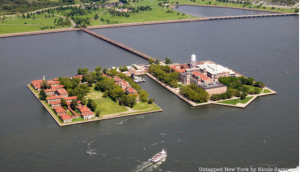
Today Ellis Island is a beautifully kept 27-acre island in the Upper Bay of the Hudson River, home to a museum that tells the story of immigration to America. But Ellis Island started out as a 3-acre mound of land peeking above the water level, home to sea gulls, oysters and not much else.
Ellis Island takes its name from Samuel Ellis, a New York businessman who owned the island in the early 1800s. The island eventually became the property of New York State and was used as part of the New York Harbor defense in the War of 1812, as was Castle Garden, you may recall.
Over the next 75 years Ellis Island was inhabited by the U.S. Army and Navy. In the latter half of the 19th century the Navy was the source of many complaints about its use of the island as a home for its powder magazines and its use of explosives. In 1890 a law was passed that sent the Navy and its powder magazine to Staten Island. The law also began funding for immigration improvements. The Castle Garden immigration station closed and immigrants entered the country through the Barge Office for the next two years.

In 1891 another law was passed that directly affected the island. A new department within the Treasury Department, the Department of Immigration, was created with a commissioner stationed in every port. Work began on the immigration station on Ellis Island. The building was built of Georgia pine and opened to welcome its first immigrant on January 1, 1892.

Everything went fine until the fire in 1897. The wooden building burned to the ground but thankfully no lives were lost. Immigrants again were processed in the Barge Office while a new brick building was built.

The new building opened on December 17, 1900 and the immigrants flooded in to the building and into the country. In 1907, 1.25 million immigrants came through Ellis Island’s doors, the highest number of people ever.

Immigration slowed during World War I. In 1921 legislation passed to limit the number of immigrants to about 350,000. In 1924 quotas were put in place that limited immigrants by their country of origin. The 1924 law also changed the way immigrants were processed. They were required to obtain a visa from an American consulate. This decreased the number of immigrants significantly, and it also decreased the need for Ellis Island since immigrants had been cleared for entry to the country by their visa.
During World War II Ellis Island was used for detaining German, Italian, and Japanese enemy aliens. Between quotas and visas the need for Ellis Island continued to wane. On November 29, 1954 the ferry “Ellis Island” made its last departure and the island was vacated. In all, Ellis Island welcomed 12 million immigrants to America.
In 1976 Ellis Island was opened for tours and then restored in the late 1980s. The island now houses a Museum of Immigration, and special tours are available of the hospital that took care of the sick and infirm.
As genealogists we love learning about the places that were important in our ancestors’ lives, but we also want to know how to research these places to find out about our ancestors’ experiences there. If you are interested in researching your immigrant ancestor, first determine when they came to America. Census records are the best place to start. The 1880 census asked where a person and their parents were born, indicating whether they were a citizen or immigrant, but the 1900 census was the first to ask specifically when they immigrated. The question was repeated in 1910, 1920, and 1930.
Once you have an idea of when your ancestor immigrated, you can search for them in passenger lists. When the immigrant boarded the ship in Europe, they were asked questions about themselves and their trip, and the answers were recorded on the passenger list. When the immigrant landed at Ellis Island they were asked the same questions again. and the answers were compared.
You have many options for finding your ancestor’s passenger list. The Ellis Island website has a searchable database of the immigrants who passed through its doors. Steven P. Morse has a website that offers more ways for searching the database. FamilySearch, which is free, and all the commercial genealogy databases (including Ancestry, which you can now search from home with a Cook Library card) provide ways to search for these records.
What if you don’t find your ancestor in the Ellis Island passenger lists? Make sure your ancestor came to American during the years that Ellis Island was open. Another possibility is that your ancestor arrived in America at a port other than New York. We’ll examine this in our next post. Until then, keep digging and happy researching!
Sources used:
“Closing the Door on Immigration,” National Park Service
https://www.nps.gov/articles/closing-the-door-on-immigration.htm#:~:text=The%20Emergency%20Quota%20Act%20of,the%20quotas%20stricter%20and%20permanent.
“Ellis Island Chronology,” National Park Service
https://www.nps.gov/elis/learn/historyculture/ellis-island-chronology.htm
“Ellis Island, Guided Tours,” National Park Service
https://www.nps.gov/elis/planyourvisit/guidedtours.htm
“Ellis Island History,” LibertyEllis Foundation
https://www.libertyellisfoundation.org/ellis-island-history
“The Immigration Act of 1924,” Department of State, Office of the Historian
https://history.state.gov/milestones/1921-1936/immigration-act
“Immigration Act of 1924,” Wikipedia
https://en.wikipedia.org/wiki/Immigration_Act_of_1924
The Nation’s Immigration Laws 1920 – Today,” Pew Research Center
https://www.pewresearch.org/hispanic/2015/09/28/chapter-1-the-nations-immigration-laws-1920-to-today/
“Origins of the Federal Immigration Service,” U. S. Citizenship and Immigration Services
https://www.uscis.gov/history-and-genealogy/our-history/overview-ins-history/origins-federal-immigration-service
“So all immigrants came through Ellis Island, right?” My Genealogy Hound
https://www.mygenealogyhound.com/genealogy-articles/ellis-island-castle-garden-barge-office-immigration-history.htm
Discover more from Cook Memorial Public Library District
Subscribe to get the latest posts sent to your email.
Categories: Genealogy
